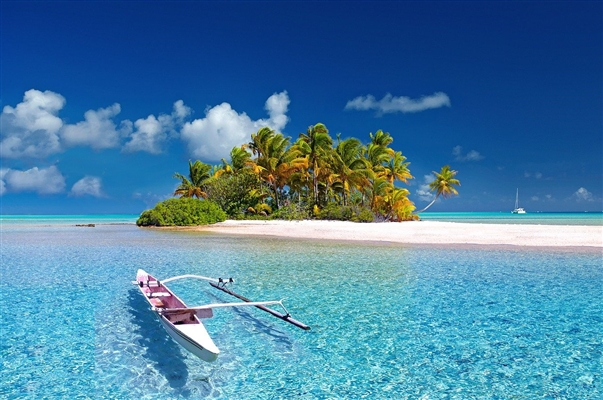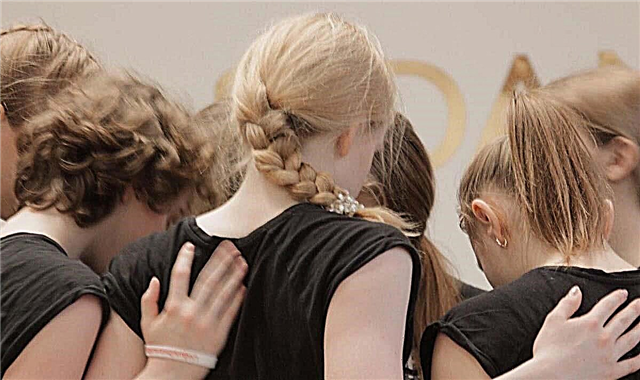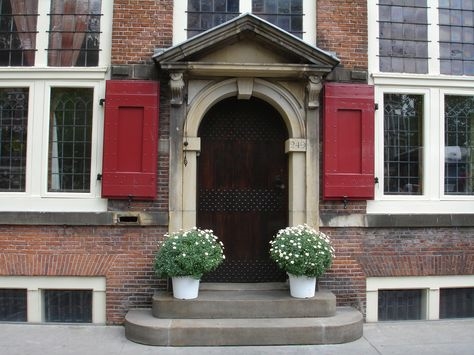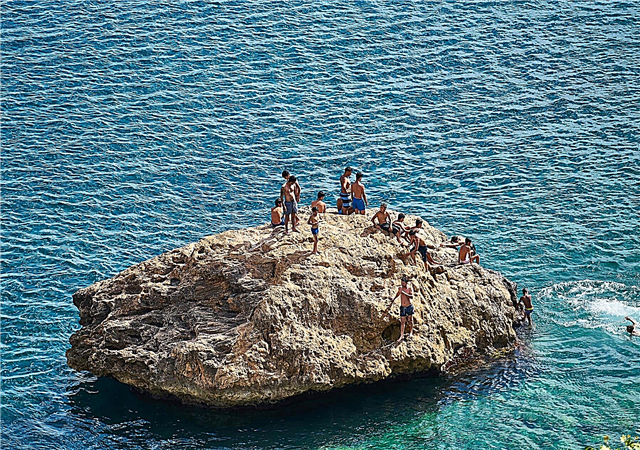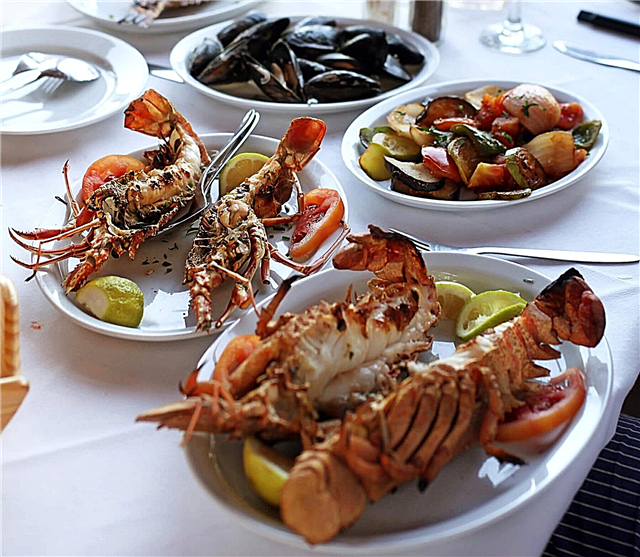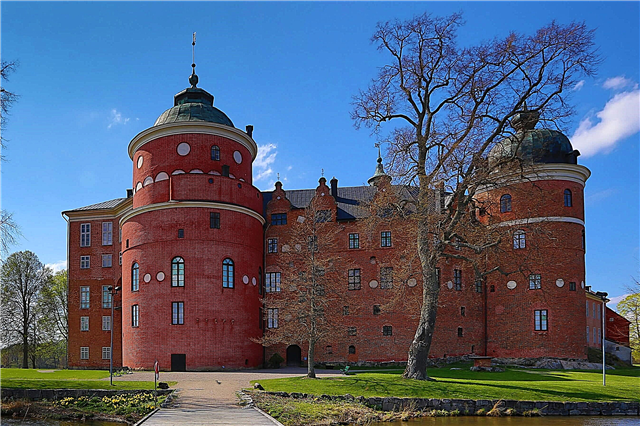Sweden cherishes one of the main symbols of its greatness - numerous castles, from severe fortifications to luxurious royal residences. Almost all of them are in excellent condition, so tourists from all over the world come to see them and soak up the spirit of the Middle Ages. There are several hundred castle complexes in Sweden, built between the 12th and 19th centuries.
Today, they belong to individuals, the state, the royal family, or public organizations. They house museums, hotels, offices, restaurants, or they are simply used for living. In any case, all these structures are a unique historical heritage protected by the state. Most of the castles are located in the south of the country. As a rule, they are erected along the banks of reservoirs, and picturesque parks are laid out nearby.
The most interesting medieval castles and fortresses
List, photos with names and descriptions of ancient castles!
Visby city wall
The ancient port city of Visby on the island of Gotland is the best-preserved medieval settlement in Scandinavia. Until now, it is surrounded by powerful walls 3.5 meters high and 27 towers 15-20 meters high, which were erected to protect the townspeople from pirates. The oldest tower - Powder Tower - was built at the beginning of the 12th century. The total length of the fortification is 3.5 km. Largely thanks to him, the city came under the protection of UNESCO.

Gripsholm
Located on the coast of the lake in the town of Mariefred. It was founded for the Chancellor's family in 1380, after 150 years it passed into the possession of the Swedish king. It was gradually rebuilt and acquired its current features. It belonged to the royal family until 1713. In the 18th century it was used as a prison. Later, under Gustav III, a court theater was created in one of the towers. Today the castle houses a museum and a state portrait gallery.

Vadstensky
It was built in 1545 by order of the Swedish king to protect the capital from the attack of the Danes. Located on Lake Vettern. Until 1716 it served as a royal residence, later it began to be used as a granary. In our time, the interiors have been restored, the ramparts have been restored. A museum was opened in the castle, as well as a tourist information center, an archive, and the office of the Vadstena Academy. In summer, concerts are held in the courtyard.

Squid
The history of the Renaissance castle in Kalmar began in 1160 with the construction of a watchtower. Later, a powerful fortification was formed around it, protecting the townspeople from the enemy. The heads of state often met here for negotiations and signing agreements. The chapel was built in 1592. Since the 17th century, the castle housed warehouses, a brewery, and a prison. Today a museum is organized here.

Lekko
It rises on one of the islands of the largest lake in Sweden - Venern. National monument of the country. Leads its history since 1298, several times it was radically rebuilt, changed many owners. It acquired its final appearance with baroque elements in the 17th century, being in the possession of the noble Swedish family of De la Gardie. Today the castle and the surrounding garden are open to tourists, and during the summer they host exhibitions and performances.

Örebro
National Monument of Sweden. Located in the city of Örebro, on the banks of the Swarton River. Built to protect against aggressive neighbors in 1240. He participated in battles until the 16th century. It was repeatedly restored, only one tower has survived in its original form. Over the past 4 centuries, it served as a royal castle, prison, warehouse, governor's residence. Today it houses a museum, hotel, school, cafe.

Skokloster
Built in the 1600s for Field Marshal Count Wrangel, one of the richest men in Sweden. Located on Lake Mälaren. It is a huge white-stone building with 4 corner towers. The only castle in Europe that has remained absolutely unchanged since the 17th century. Embodies the luxury of the Baroque style. His collections include weapons, furniture, textiles, books, carpets, paintings. A museum has been established in the castle.

Uppsala
The famous building of the city of Uppsala was founded in 1549 by order of the Swedish king. The majestic mansion has been under construction for over 100 years. He dominated the residence of the archbishop and was intended to remind him of the supremacy of royal power. As a result of a fire in 1702, most of the building burned down; it was rebuilt only in the 19th century. Today it houses 3 museums and the governor's office. A botanical garden is located nearby.

Sofier
Located by the sea, 5 km from Helsingborg. As a wedding present, it was presented in 1905 to the future king Gustaf Adolf and his wife Margaret. The crown princess laid out gardens around the castle, rhododendrons became the main decoration. Today, about 500 species are grown, and tourists come to see them bloom. The castle was transferred to the city in 1973, but the royal family still finances the work of the gardeners.

Malmöhus
It is a complex of stone structures surrounded by a massive wall and a moat with water. Built in 1542 for the king of Denmark. Intended to protect the western Danish borders. On its territory there were barracks and artillery pieces, and later - a prison. Today, several museums are open here, introducing the history of the city of Malmö, the works of Scandinavian artists, as well as the development of scientific and technological progress in Sweden.

Landskrona
A powerful defensive fortress. It is located in the port city of the same name in the south of Sweden. Built in the 16th century by a Danish king to protect the bay. The system of fortifications and several moats around the castle is one of the largest and best preserved in Europe. During the 19th-20th centuries, the fortress was used as a prison. Today it is available for excursions, events. There is a museum, cafe, recreation area.

Marswinsholm
This elegant Renaissance castle with two towers, surrounded by a pond, was built in the 1640s for a noble Dane. Located 12 km from the town of Ystad. During its history, it changed many owners, was often rebuilt. It is impossible to get inside the castle today, it is rented out for various celebrations. Theatrical performances take place in the palace park in the summer. An exhibition of sculptures has been held since 2007.

Karlsten Fortress
The main attraction of the city of Marstrand. Built in the 17th century, it protected the approaches to an important ice-free harbor. She survived 2 enemy attacks, was even conquered, but eventually returned to Sweden. In the 19th century it was used as a prison for dangerous criminals. Today, guided tours are held here, and reconstructions of medieval battles are held in the courtyard. A hotel is located in the former barracks.

Drottningscher
It is a powerful citadel with 4 corner bastions. Located on the island of Aspö in the vicinity of the city of Karlskrona. Construction was carried out for 70 years, starting in 1680. The fortress lost its military significance by the end of the 19th century. Today, excursions are held here, museum expositions are presented. A restaurant is open in the courtyard, in the commandant's house. You can get to the fortress by ferry from Karlskrona pier.

Borgholm
Initially, the defensive fortress in Borgholm was erected in the XII century, in subsequent centuries it was rebuilt many times, passed from the Danes to the Swedes and back. The last reconstruction was carried out in the 18th century. But after a fire that happened in 1806, the fortress turned into ruins and was no longer rebuilt. Today it is open to visitors, there is a museum, and theatrical performances are periodically held.

Nykoping
The White Tower by the river in the center of the town of Nykoping is almost everything that has survived from the powerful structure that protected the approaches to Stockholm. The defensive fortress was built in the XII century, then it was rebuilt and fortified many times. In the 16th century it was a royal residence. Badly damaged by fire in 1665. In the last century, some of the buildings were restored. It houses a museum, gift shop and restaurant.

Svaneholm
Located in the south of the country, 26 km from Malmö, on an island near Lake Svane. It was erected in the 16th century for the nobleman Sparre, then rebuilt many times. The last owner of the castle in the 1930s was Karl Augustin Ehrensvärd. It has electricity and central heating. After his death, the palace was transferred to the ownership of the city, and a museum was opened here. In addition to the lake, the castle is surrounded by flowering gardens, meadows, and a forest.

Trolleholm
Magnificent castle with round towers, surrounded by a park and mirrored canals. Located 9 km from the town of Eslev. It was erected at the beginning of the 15th century, subsequently rebuilt and renamed three times. In the 17th century it became the family estate of the Trolle dynasty. It acquired its present appearance in the Renaissance style during modernization in 1887. It is famous for its library with rare books. Only the park and the surroundings of the castle are accessible for inspection.

Krunuberg
Located 5 km north of the city of Vaxjo, on Lake Helgation. It was built as an episcopal palace in 1444. Used for defensive purposes. It lost its military significance in the middle of the 17th century, since then it began to deteriorate and gradually turned into ruins. Open to tourists during the summer. On its territory, theatrical performances, carnivals in medieval costumes, and reconstructions of battles are held.

Vaxholm Fortress
Powerful bastions of this fortress were erected between the islands of Rinde and Waksen, on the outskirts of the capital of the state. The citadel dates back to the beginning of the 16th century. Several times she repulsed attacks on Stockholm, was constantly rebuilt and strengthened. In the 19th century, it lost its military purpose. Today it is an outstanding architectural monument, on the territory of which there is a military museum, a hotel, conference rooms, and a cafe.

Trolle Lyngby
Renaissance medieval castle in the south of Sweden. Located on a small island surrounded by a deep moat. It was erected in the XIV-XV centuries for a noble Danish family. It acquired its present appearance by the end of the 17th century. A church was built near the castle. Inside, the interiors in the Rococo and neoclassicism style, original furniture, one of the best private libraries in the country have been preserved. The castle is owned by the count family Trolle-Wachtmeister.

Mölsacker
It rises on the shores of Lake Mälaren, 70 km from the capital. A magnificent example of graceful baroque architecture. It acquired its present appearance by the end of the 17th century, when it belonged to the aristocratic Goob family. A fire that broke out in 1945 almost completely destroyed the building. It took 50 years to restore it. Today the palace and the surrounding park are open to the public. A foundry has been opened on the territory.

Glimmingehus
A powerful medieval building 10 km from the city of Simrishamn. It was built at the beginning of the 16th century by order of one of the Danish knights. It is a rectangular stone structure 30 meters long, 12 meters wide and 26 meters high. Inside there are many false doors, secret pits, dead-end corridors, killer holes and so on. Central heating is provided. The citadel is surrounded by a moat with water. Today, a museum, restaurant and shop are open here.

Skarhult
A luxurious building in the south of Sweden, surrounded by a landscaped well-kept park. One of the well-preserved Renaissance Scandinavian palace complexes. The barons von Schwerin, the owners of the estate, still live in it and run the neighboring farm. Since 2014, the territory of the castle has become accessible to tourists. Guided tours are conducted through its halls and the adjacent park, and then guests are treated to a delicious lunch in the basement cafe.

Torup
Located in the south of Sweden, 15 km from the city of Malmö. It was erected at the beginning of the 16th century. It is a 3-storey brick building in the shape of a square with one octagonal and one round tower. The castle is surrounded by agricultural land, a picturesque park, and a beech forest. Since 1970, the building has been owned by the city of Malmö. Excursions are possible by agreement. A cultural trail called “Life around the castle” has been developed for tourists.

Osgaard
Located on the shores of Lake Mälaren, in the town of Mariefred. The history dates back to 1681. It combines elements of Baroque and Scandinavian style. Famous for its luxurious interior. It flourished in 1937 when it was acquired by the writer Hildin Shellen, a fan of art evenings and other social events. Today the castle is rented out for celebrations, in particular weddings.

Bohus Fortress
Located on a hill on the island of Bagaholm, on the border with Norway. It was founded by order of the Norwegian king in 1308 for protection from southern neighbors. It became famous for the fact that in the history of its existence it was subjected to siege 14 times, but it was never taken. Today it is a ruin overgrown with grass, with the only surviving tower, ramparts and magnificent views of the river valley. In summer, it is available for tourists.

Penningby
Located in a seaside valley, 70 km from Stockholm. Construction began at the end of the 14th century. At the beginning of the 19th century, an English garden was laid out in front of the castle. In 1831 it was damaged in a fire, after which part of the building was completely rebuilt. The last restoration was carried out in the 50s of the last century. Today, an internal tour of the castle is available during the summer. Refers to objects of national cultural heritage.

Castellet
The castle was built in 1667 as a defensive structure. Located on an island in the center of Stockholm. In 1845 he was badly damaged by an explosion in the laboratory for the manufacture of gunpowder, which was located on the territory of the fort. The dominant feature of the new image of the fortress is a 20-meter round red brick tower. Every morning the country's naval flag is hoisted over it, as a symbol of peaceful life and prosperity in Sweden.

Rosersburg
Located 26 km from Stockholm, on the shores of Lake Mälaren. Built in the Renaissance style in the 1630s for the family of the Rickskanzler Oxenshern. A century later, it was modernized with the addition of baroque elements. Since 1757 it served as a royal residence, acquired many new luxurious interiors. At the end of the 19th century, it was transferred to the army. Since 1960, the land and part of the buildings are under the jurisdiction of the Office of the Rescue Service. A museum is opened in the central building.


